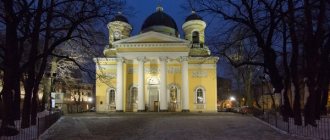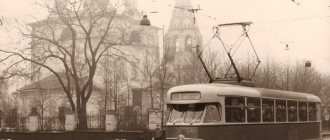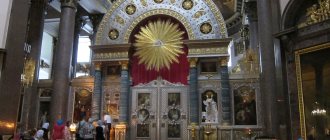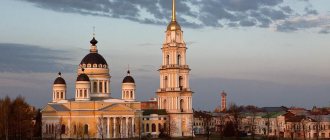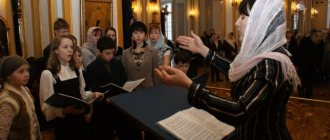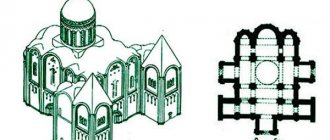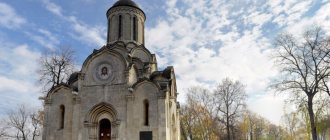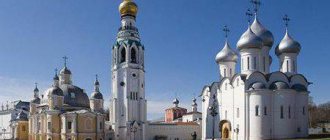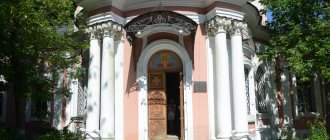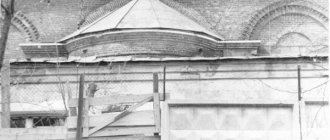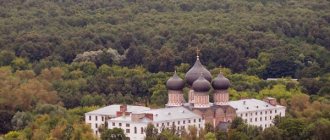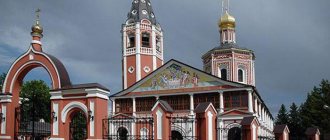The Peterhof Cathedral of the Holy Apostles Peter and Paul is located on the northern bank of Olga Pond, not far from the palace and park ensemble. The cathedral, amazing in its beauty, is visible many kilometers from the city and is rightfully considered the last great temple of the Russian Empire.
The five-domed majestic building in neo-Russian style reaches a height of 70 m and can accommodate over 800 people. The temple was erected in pre-revolutionary times and is stylistically similar to St. Basil's Cathedral in Moscow and the Church of the Savior on Spilled Blood in St. Petersburg. At the same time, the Peter and Paul Cathedral in Peterhof stands out for its special beauty and grace of multi-tiered forms.
The inside of the temple is no less impressive than the outside: amazing story paintings on the walls and vaults, a central majolica iconostasis, stylized ornaments, and faces of saints. All this creates an atmosphere of solemnity and tranquility.
© Sergey Arkhipkin
The Cathedral of the Apostles Peter and Paul belongs to the St. Petersburg diocese of the Russian Orthodox Church, and for many years has been the center of spiritual life for thousands of Christians. In addition to its religious value, the temple is important as a monument of historical and cultural heritage, and is under state guardianship.
Peter and Paul Cathedral in Peterhof today
The temple is located on the shoreline of Olga Pond on the territory of New Peterhof (St. Petersburg Avenue) near the legendary architectural creation “Peterhof”. Today, the rector of this holy place is Archpriest Mikhail Teryushov.
The Cathedral of Peter and Paul in Peterhof received its name in honor of the supreme apostles - the most famous disciples of Christ the Savior, who, thanks to their ardent service to God, received respect in the Christian environment.
The temple consists of several chapels that are dedicated to Peter and Paul, Ksenia of Milass, Alexander Nevsky and Ksenia of Petersburg. Nowadays, the church is a place of cultural heritage of the Russian Federation at the regional level and is recorded in the appropriate register.
LiveInternetLiveInternet
The Cathedral of Saints Peter and Paul
is an Orthodox church in Peterhof. Located in New Peterhof, on the banks of the Olgin Pond, on St. Petersburg Avenue, near the Peterhof palace and park ensemble.
The first to petition for the construction of a new church in Peterhof in 1892 was the head of the court clergy, Protopresbyter John Yanyshev. The petition was caused by the fact that, despite the large number of churches, including the Church of the Exaltation of the Cross, there was no church in the city that could accommodate a large number of parishioners - ordinary residents.
Sverchkov Nicholas - Alexander III
Alexander III approved the idea of construction and personally determined the location near the Tsaritsynsky (Olgin) pond, and also named the architects who were commissioned for the projects - N.I.
de Rochefeor, A.I. Semenov, L.N. Benoit and N.V. Sultanov. Tsarevich Alexander Alexandrovich in the uniform of the Life Guards Ataman Regiment, of which he was the chief. 1867, S. Zaryanko
Ivan Kramskoi. A Portrait of Tsar Aleksandr Aleksandrovich. 1886
Kulikov Ivan — Alexander III
Khudoyarov Vasily Pavlovich. Portrait of Grand Duke Tsarevich Alexander Alexandrovich
Schilder Andrew — Portrait of Alexander III (1845-1894), 19th century
Alexander III of Russia born 1845 died 1894. Emperor of Russia
E.i.v. Heir Tsarevich Alexander Alexandrovich
Alexander III of Russia (1845-1894) Alexandrovich Romanov, Emperor of Russia (1881-1894) the Peacemaker c19th Engraving Portrait
Alexander III Alexandrovich
(February 26 [March 10] 1845, Anichkov Palace, St. Petersburg - October 20 [November 1] 1894, Livadia Palace, Crimea) - Emperor of All Russia, Tsar of Poland and Grand Duke of Finland from March 1 [13], 1881. Son of Emperor Alexander II and grandson of Nicholas I; father of the last Russian monarch, Nicholas II. During the reign of Alexander III, Russia did not wage a single war. For maintaining peace, the monarch received the official nickname Tsar-Peacemaker. He adhered to conservative-protective (nationalist) views and pursued a policy of counter-reforms, as well as the Russification of the national outskirts. Concluded a Franco-Russian alliance.
Maria Feodorovna, Dowager Empress of Russia (1847–1928) c.1910
Maria Feodorovna
(Feodorovna) (born Maria Sophia Frederikke Dagmar (Dagmara), dated Marie Sophie Frederikke Dagmar; November 14 (26), 1847, Copenhagen, Denmark - October 13, 1928, Vidøre Castle near Klampenborg, Denmark) - Russian Empress, wife of Alexander III (from October 28, 1866), mother of Emperor Nicholas II.
Khudoyarov Vasily Pavlovich. Portrait of Empress Maria Feodorovna, wife of Emperor Alexander III
Makovsky Alexander - Emperor Nicholas II Nicholas
II Alexandrovich
(6 [18] May 1868, Tsarskoe Selo - 17 July 1918, Yekaterinburg) - Emperor of All Russia, Tsar of Poland and Grand Duke of Finland (20 October [1 November] 1894 - 2 [15] March 1917). From the Imperial House of Romanov. Colonel of the Guard (1892); in addition, from the British monarchs he had the ranks of admiral of the fleet (May 28 (June 10), 1908) and field marshal of the British army (December 18 (31), 1915). The reign of Nicholas II was marked by the economic development of Russia and at the same time the growth of socio-political contradictions in it, the revolutionary movement, which resulted in the revolution of 1905-1907, the February Revolution of 1917 and the October Revolution; in foreign policy - expansion in the Far East, the war with Japan, as well as Russia's participation in the military blocs of European powers and the First World War. Nicholas II abdicated the throne during the February Revolution of 1917, after which he and his family were under house arrest in the Alexander Palace of Tsarskoye Selo. In the summer of 1917, by decision of the Provisional Government, he was sent into exile with his family and associates to Tobolsk, and in the spring of 1918 he was moved by the Bolsheviks to Yekaterinburg, where in July 1918, in the basement of Ipatiev’s house, he was shot along with his family and four associates. He was canonized (along with his wife and children) by the Russian Orthodox Church as a passion-bearer on August 20, 2000; earlier, in 1981, he was glorified by the Russian Church Abroad as a martyr.
Icon of the Holy Royal Passion-Bearers
Icon of the Holy Royal Passion-Bearers
Icon of the Holy Royal Passion-Bearers
Icon of the Holy Royal Passion-Bearers
Attached to the cathedral was the stone chapel of St. Joseph the Songwriter, built in 1868 (architect N. L. Benois), destroyed in 1957. For many years the cathedral was the main temple of Peterhof.
Like many other monuments of Peterhof, the building was badly damaged during the war. During the Nazi occupation of New Peterhof, German spotters settled on the bell tower. From here Kronstadt, the Oranienbaum bridgehead, the Gulf of Finland, and Vasilyevsky Island were clearly visible. From here the enemy adjusted artillery fire. The bell tower was destroyed by return fire. View from the Olgina Pond embankment
After the war, the temple building was used as a container warehouse.
On July 9, 1994, the temple was completely consecrated by Patriarch Alexy II. The cathedral was built in the forms of Russian architecture of the 16th-17th centuries. Designed for 800 people. Externally, the temple has a pyramidal shape and is crowned with five hipped domes. Its height is about 70 meters.
The walls, lined with dark red and light yellow bricks and glazed tiles, are decorated with sandstone columns and tiles. The apses are decorated with blind columnar arches. Church of Peter and Paul. Altar part. Frescoes
Covered gallery around the altar
Decorative majolica inlay of the facades of the Cathedral of St. Apostles Peter and Paul in Peterhof
On the facades were placed icons of saints - patrons of members of the imperial family.
Church of Peter and Paul from the southern facade. Porch of Archangel Michael
Church of Peter and Paul. Icon of Archangel Michael above the entrance
Apostles Peter and Paul - a fragment of the western facade of the Cathedral of Peter and Paul in Peterhof
Catherine the Great Martyr, Our Lady of Feodorov, St. Ksenia - icons on the facade of the cathedral
Fragment of the southern facade of the Peter and Paul Cathedral in Peterhof. Icons above the entrance of the narthex of St. equal to book Vladimir
Entrance to the temple from Petersburg Avenue
Entrance to the temple from Petersburg Avenue
Nicholas the Wonderworker - icon on the facade of the Cathedral of Peter and Paul in Peterhof
The cathedral is surrounded by a covered gallery, in which there are special rooms for the blessing of eggs, Easter cakes and Easter.
Apses and bypass gallery of the Cathedral of Peter and Paul in Peterhof
At each of the four entrances, a canopy for outerwear was designed. On the side facades there are stairs to the choir.
At the main entrance there is a hipped belfry, a chapel and two porches. The entrance to the chapel is decorated with an arched portal made of planked stone.
In order to illuminate the interior of the tents, windows were made.
They are currently used for tourism purposes, as the windows offer beautiful views of the surrounding area: St. Petersburg, Babigon, Kronstadt and others.
Spiral staircase leading to the observation deck of the Peter and Paul Cathedral in Peterhof
The domes of the temple are connected by a gallery; there are windows in the walls, suitable not only for lighting, but also for observing the surroundings.
At the transformer substation you can see images of the vision of the youth Bartholomew and Seraphim of Sarov.
Transformer substation and boiler house
Transformer substation
Boiler room
History of foundation, construction, whose idea
In 1892, the emperor received an appeal to begin the construction of a temple in Peterhof, which would be able to accommodate many ordinary parishioners within its walls. The initiator of the message turned out to be Protopresbyter John Yanyshev at that time. Alexander III held a competition among architects and ultimately chose the design of Nikolai Sultanov in 1893.
And a few months later, preparations for construction began: a deep pit was dug, sheds and an engineer’s house were erected. The foundation stone of the Peter and Paul Cathedral in Peterhof was laid on August 6, 1895, and Vasily Kosyakov was appointed project manager.
After only 4 years, the main building was erected, and after another 3 years, finishing work was carried out, space heating and a ventilation system were installed. At the last stage of construction, the iconostasis was installed, the temple was painted, and a park was planted. During the same period, a school, a boiler house and an electrical station were built at the church.
On June 25, 1905, the cathedral was sprinkled with holy water. The imperial couple was present at this event. Additionally, the premises of the chapel named after Joseph the Songwriter were also attached to the temple, which was destroyed a little more than half a century later. In 1938 they wanted to blow up the building, and 3 years later the decoration of its domes was destroyed.
The cathedral was severely damaged during the war, but already in 1974 it was transferred to the care of the state.
In 1987, restoration work was completed, after which in 1989 the building was returned to the structure of the church, and a year later new repairs began: the basements were drained, electricity and water supplies were restored, and the courtyard was cleaned. On June 9, 1994, the shrine was consecrated by Alexy II.
A little history
Construction of the cathedral began at the end of the 19th century. The need to build this place was indicated by the fact that almost all the churches of St. Petersburg and Peterhof were made exclusively for the royal family, thus putting ordinary parishioners in a very uncomfortable position. The order to build the cathedral in this exact place was given by Tsar Alexander III himself. The work was carried out from 1894 to 1905. The new cathedral was consecrated in the presence of Emperor Nicholas II.
Until 1934, residents of the entire area gathered at the cathedral for services, weddings, baptisms and prayers. Then, under the influence of the anti-religious policy of the USSR, the building was closed and looted. The golden cladding of the domes was torn off, crosses and icons were taken out. What once pleased the eye of any person passing by and attracted everyone to go inside has turned into a sad sight. During the war, German troops took refuge here, so the northern side, from which an observer of the movements of ships looked out onto the Gulf of Finland, was completely destroyed.
Only in the 80s did work begin on the restoration of the temple. By 1989 they were completed. In the same year, believers succeeded in ordering the establishment of a church here. In the early 90s, the decoration was restored. However, some residual restoration work continues to this day.
Architect, exterior decoration, architectural ensemble
The Peter and Paul Cathedral was built in the format of Russian architects of the 16th-17th centuries. The building is designed to accommodate 800 people at a time. In Peterhof, this building is one of the tallest - 70 m. Externally, the church has a shape similar to a pyramid, topped with 5 tent-shaped domes. Wall cladding made of red and yellow bricks.
On the facades were placed images of holy people - protectors of the family of heirs to the throne. The building itself is surrounded by a closed gallery equipped with specialized rooms for performing the rite of consecration.
All 4 entrances to the building have canopies for storing outerwear. The facades located on the sides are equipped with flights of stairs for the choir. Two porches, a bell ring, and a chapel are attached to the main entrance.
Interior of the cathedral
The interior of the cathedral received its decoration thanks to the icon painters Safonov and Kolupaev. The main iconostasis was built following the example of the Church of St. George, located in Venice. In the center of the building inside, a silver crucifix was installed in an arch.
Peter and Paul Cathedral, Peterhof inside.
The iconostases of the chapel, as well as the side chapels, were made of Carrara marble. The images themselves were painted by the artist Guryanov. The confessional is located in the northeast of the building, and the chapel for the dead is in the northwest.
Clergy and mentors
Over the entire period of the cathedral's existence, several priests served within its walls.
Their list is given in the table:
| date | Confessors |
| summer 1905 – autumn 1906 | Nalimov V.A. |
| autumn 1906 – autumn 1918 | Dyakonov M.A. |
| autumn 1918 – winter 1919 | Hieromonk Nikolai |
| spring 1934 - winter 1937 | Goremykin I. F. |
| 1938—1989 | The temple was closed |
| winter 1990 - spring 1990 | Victor I.G. |
| spring 1990 - summer 1990 | Kuryanov S. |
| autumn 1990 - summer 1991 | Kochmaruk A. |
| summer 1991 - winter 1992 | Kovalchuk G.V. |
| winter 1992 - summer 1996 | Fortunatov V.A. |
| summer 1996 - 2013 | Kudryashov A.V. |
| 2013—autumn 2017 | Kudryashov P.A. |
| fall 2022 - present | Mikhail Teryushov |
Social work and everyday life today
The Peterhof Church of Peter and Paul leaves no one in trouble. A special social worker works here two days a week, whose task is to provide assistance to people who find themselves in difficult life situations for various reasons.
Young people are also given close attention and the Angelos club is open for them. In addition, work is regularly carried out with those who have just begun their journey in Orthodoxy or are beginning to look for their way to the temple. For this purpose, there is always at least one priest in the cathedral.
Every Saturday during the Divine Liturgy, only amateurs sing, and everyone can take part in this chant.
Worship services and other visiting opportunities
The doors of the temple are open to all those who suffer at any time of the day. Every Saturday a Divine Liturgy is held, in which only non-professional singers sing. Anyone can take part in it.
There is also a schedule of events for each day:
- 9:00 - confession;
- 9:30 — Divine Liturgy;
- 17:00 - evening service.
Sunday School
Literally 100 years ago, the holy youth Tsarevich Alexy suffered martyrdom, which is why he was canonized. For many young people today, his faith, courage and humility are an edifying example.
About 60 children attend Sunday school at the Cathedral of Peter and Paul, and they are taught in three age groups. The classes themselves are held from 12.30 to 16.00 every Sunday.
Training takes place in the following disciplines:
- Holy Bible.
- Fundamentals of Orthodox teaching.
- God's Law.
- Church choir.
- Art studio "Obraz".
- Theatre studio.
Also, every Saturday from 19.30 to 21.00 classes are held for adults, led by Archpriest John. The post of school director is occupied by Elena Vladimirovna Repina.
What to see nearby
In addition to the world-famous lower park of Peterhof with its cascade of fountains, firecrackers, a palace with gilded facades, a labyrinth and other attractions, Petrodvorets is bursting with monuments of architecture and history of the Romanov royal family.
I consider Alexandria Park a must-see in New Peterhof, where there is an incredibly beautiful Gothic chapel, unique of its kind for our region. In addition, not far from the cathedral, within walking distance are the Imperial Stables. Just seeing them, you can understand in what grandeur and luxury the ruling family lived. After all, if so much space was allocated only for their horses, so much effort and money were invested, what can we say about the emperor himself?
To the west of New Peterhof is the Old Peterhof, for which I have special warm feelings because of its authenticity and being lost in time. It is much more difficult to find attractions in Old Peterhof; not all of them are on the map. The main ones are Sergievka Park and Sovetny Dacha Park, which I wrote about here. If you want to conquer the entire region of the southern coast of the Gulf of Finland, experiencing the life of the Romanovs and antiquity to the fullest, then take a ride to Lomonosov, where the magnificent Oranienbaum is located - an amazing palace ensemble.
Patronal holidays
The Cathedral of Peter and Paul in Peterhof is a place where the memory of several saints is revered.
Therefore, the following holidays are celebrated in the temple:
- January 29 – Worship of honest chains.
- February 6 – Venerable Xenia of Milas.
- June 5 – Cathedral of Saints of Rostov and Yaroslavl.
- July 6 – Cathedral of Saints of the city of Vladimir.
- July 7 – Cathedral of St. Petersburg Saints.
- July 12 – Peter and Paul.
- July 13 – 12 apostles.
- September 12 – Transfer of relics from Vladimir to St. Petersburg.
- December 1 – Council of Saints of the Estonian Land.
- December 6 – Burial in Vladimir at the Nativity Monastery.
Opening hours for visitors
Any Orthodox Christian, or anyone who wants to be baptized in an Orthodox church, can visit the Peter and Paul Cathedral of Peterhof daily, since services are held in this shrine every day. Confession begins at 9 am, and half an hour later the Liturgy begins.
Evening services are held from 17.00. Every Sunday, akathists are also read to Christ the Savior and the Mother of God (alternately), and every Thursday - to Nicholas the Wonderworker and the holy apostles Peter and Paul.
How to get there
To get to the Peter and Paul Cathedral, Peterhof, you will need:
- Get to the Gorkovskaya metro station.
- Walk a few minutes through Alexander Park.
St. Peter's Basilica - the main site of the Vatican
The cost of excursion tickets is 450 rubles. for adults, for students and schoolchildren - 250 rubles. For pensioners it will be 200 rubles*
Note! Various events and concerts are often held on the territory of the temple with the participation of the best choirs and ensembles. Also, the Sunday school organizes film lectures dedicated to significant dates, such as the 1030th anniversary of the Baptism of Rus' and so on.
Interesting facts about the cathedral
During the government under the leadership of Stalin, they wanted to demolish the temple. However, since it was one of the most convenient and significant landmarks for navigation, the dismantling of the building was canceled, and officials began to think about its restoration.
It is thanks to this that today the church delights its guests and parishioners. In 1993, the bass bells were donated by the German Bachmann couple from the city of Aachen.
These three cast giants were given names:
- "Holy Spirit."
- "Archangel Michael".
- "The Virgin Mary".
The Cathedral of Peter and Paul in Peterhof is also surprising in that it has a covered gallery and a canopy for clothes, and not every church in Russia can please people with such features. The cathedral has 16 crosses, and the main cross weighs 450 kg.
Where is it located, what is in the surrounding area, how to get there
The exact address of the cathedral: St. Petersburg Avenue, 32/4, bank of Olgin's pond, Peterhof. The temple rises on the banks of the Red Pond. From the upper windows of the building, which today are used as observation platforms, you can enjoy an amazing view of the entire surrounding area: the Gulf of Finland, Kronstadt, Babigon and St. Petersburg itself.
You can get to the cathedral by taxi or public transport. Not far from the shrine there is a stop called “Trading Square”, on the opposite side of which the temple stands. You can get here by bus No. 200 or 210. Or take buses 344, 351B, 351A, 352, 355, 356, 356B and get off at the Pravlenskaya stop.
Observation deck
An undeservedly little-known feature of the cathedral is that it has a colonnade that you can climb up to. Of course, its height is far from the same as it will be, say, in St. Isaac's Cathedral, but you don't need much to see Peterhof - the city is small. Walking around the dull and shabby corridor, you can see Holga Pond, near which the cathedral stands, the Upper Park and the golden dome of the royal church; somewhere in the distance, in good weather, you can see Kronstadt. In addition to all this, low residential buildings of Peterhof will be scattered here and there around you.
The entrance to the colonnade is open from 10:00 to 18:00. A ticket will cost you 100 rubles (children have a discount of 50 rubles, it seems).
Information for pilgrims
The basic rules for visiting the cathedral are quite simple and completely echo the Orthodox canons.
They are observed in the following order:
- When entering the temple, be sure to cross yourself.
- Men must take off their hats, women must put them on.
- Clothing must be modest and closed (men are not allowed to enter in shorts and T-shirts, women are not allowed to wear miniskirts or pants).
- It is prohibited to talk during services, use a mobile phone inside the church, or take photos or videos without the permission of the priest.
- Women venerate icons and other sacred objects with painted lips.
Inside the Cathedral of Peter and Paul, parishioners, pilgrims and tourists can purchase various icons, including the apostles. There is also the opportunity to buy crosses, religious literature, and candles. In the immediate vicinity of the temple there are several hotels, among which “Samson”, “Hotel Nadezhda” stands out.
